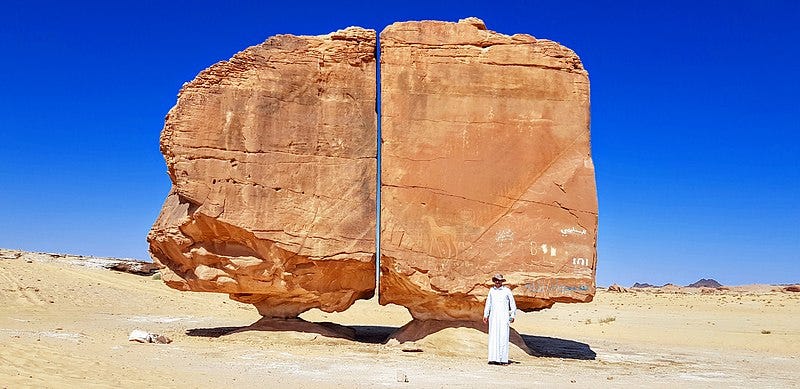Laser Precision: What Split the Ancient Al Naslaa Rock?
Renowned for its spectacular rock art and rich historical heritage, the Tayma oasis in Saudi Arabia was once a bustling hub on the ancient trade routes. This oasis hosted Nabonidus, a Babylonian king, and appears in both Assyrian and Biblical records as a prominent trading stop. Dating back nearly 4000 years, the region boasts prolific rock art. Among these formations, the Al Naslaa rock stands out, a sandstone formation teetering atop a naturally eroded pedestal, split right down the middle by a perfectly straight fracture that gives the appearance of a laser cut.
Sculptures of the Arabian Sands
The Arabian Peninsula is largely composed of limestone, sandstone, and shale, which are laid over the west Arabian crystalline shield and a southern crystalline complex, remnants of prehistoric shallow sea environments. Over time, the merciless winds and rare rains of the Arabian desert have sculpted these rocks, creating captivating formations.

This split block carries significant archaeological weight due to the beautifully engraved rock art resembling a horse or camel. The lower section of the formation suggests it could be a ventifact—a geological formation resulting from the constant sandblasting of wind against rock. This process often results in unusually shaped rocks with smooth surfaces.
The White Desert of Egypt showcases ventifacts that resemble massive stone mushrooms sprouting from the earth. It's uncertain if the Al Naslaa formation is indeed a ventifact, although the bottom part that connects it to the ground suggests so. The smooth surface of the block's upper part lends credence to this theory, though its angular shape questions the claim.

Cracking the Rock: Weather or Lasers?
Geologists have theorized that the rock's remarkable fracture was caused by an offset in the ground beneath, forcing the rock to split. The region may be an old fault line, where the rock becomes fragile and erodes more easily, causing the straight cut when sand swept into the crevices over millennia.
Alternatively, the fracture may be due to the rock's jointing—the process where the rock is torn apart along weak zones due to pressure. Joints often appear almost artificially straight. In some climates, ice forms in these cracks, causing them to widen until the rock separates. The Al Naslaa rock has a few other fractures parallel to the major one, which might be joints, with the larger fracture possibly being a more advanced stage of the same process.

Yet, some observers propose a more extraordinary explanation. They suggest an ancient, advanced civilization, or even extraterrestrials, sliced the rock using lasers. While this can't be ruled out entirely, there's little evidence supporting the idea, save for the remarkably clean cut splitting the rock. The only obvious human intervention is the rock art, which seems unrelated to the split and covers only a portion of the rock, leaving the rest as natural sandstone.
Unless the laser theory involves a stray ray-gun blast, there's little reason to believe humans or other intelligent beings deliberately split the rock. The natural explanation, given the evidence of similar natural formations, remains the most probable. This brings to mind the naturally occurring perfect cubes formed by mineral pyrite, often mistaken for human craftsmanship.
Laas Geel Complex and The Magnificent Ancient Rock Art of Somalia
The Louvre of the Desert: The Impressive Rock Paintings of Tsodilo, Botswana

Distinguishing Nature's Handiwork from Man's
People strive to make sense of patterns in their environment, often leaning on artificial constructs when natural explanations escape them. This can lead to both correct and incorrect conclusions, as demonstrated when archaeologists attempt to identify ancient stone tools—some may be genuine tools, while others are simply rocks.
Drawing from our understanding of natural phenomena and human influences, we aim to explain the mysteries around us. Yet, we must be cautious about jumping to conclusions too quickly. To assert that the Al Naslaa rock was shaped by an ancient laser implies a host of other extraordinary claims that would require equally extraordinary evidence. So, let's tread carefully, verifying our facts before entertaining fantastical theories.
Top Image: Al Naslaa split rock. Source: Disdero / CC by SA 4.0.
By Caleb Strom
References
Powers, R. W., et al. "Geology of the Arabian Peninsula—Sedimentary Geology of Saudi Arabia: USG
Survey Professional Paper, 560-D." (1966).
“Structural Geology and Tectonics” by Alessandro Grippo (2014.). Alessandro Grippo Ph.D. homepage. Available at: http://unusualplaces.org/al-naslaa-rock-formation/
“Al Naslaa Rock Formation.” Unusual Places. Available at: http://unusualplaces.org/al-naslaa-rock-formation/
“Ventifacts and Dreikanters.” Sand Atlas. Available at: http://www.sandatlas.org/ventifacts-and-dreikanters/
“Tayma.” Arabian Rock Heritage. Available at: http://saudi-archaeology.com/sites/tayma/



